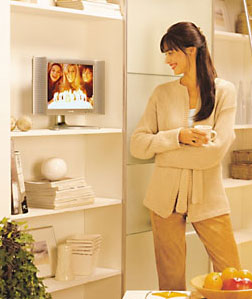|
How does a LCD (Liquid Crystal
Diode) TV operate?
LCD monitors work by blocking light. By sandwiching a solution of TN liquid
crystals between two perpendicularly aligned panes of polarized glass, it becomes possible
to manipulate the intensity of light as it passes through this crystalline matrix and out
the glass panel at the other end. Depending on the voltage of the electrical charge running
through them, liquid crystals will untwist so that the intensity of light able to pass
through the second polarized pane is affected. Basically, these displays can switch between
light states (where the liquid crystals are fully twisted) and dark states
(where the liquid crystals are fully untwisted), or somewhere along the gray scale in between.
Addressing: A liquid crystal display consists of an array of tiny segments-called "pixels"-that
are manipulated to form images or to present information. Addressing is the process by which
pixels are turned on (which disables the passage of light) and off (which enables the passage
of light) so as to create an image on the polarized display pane in front of you. So-called
active-matrix LCD TVs employ thin film transistors (TFTs), or tiny switching transistors and
capacitors arranged in a matrix on a glass substrate, to direct electric charges down columns
to reach a particular pixel. This, in turn, causes the liquid crystals to untwist and "display"
a predetermined amount of light generated by the light source-usually a florescent bulb-in
back of them.
Color (Re) Production: The light source in an active-matrix LCD monitor is a florescent bulb,
which emits white light through a polarized glass pane behind the liquid crystal solution.
Theoretically, then, you can start with a white display: This is one where its liquid crystals
are completely twisted and therefore able to direct the full spectrum of light out through
the polarized display screen in front of you. Since all wavelengths can pass through, the full
spectrum of light can be manipulated to create the desired color. To achieve a full color
pallet on your LCD display, each pixel is divided into three subpixels-red, green, and blue-that
work in conjunction to determine the LCD pixel's overall hue. These subpixels are created by
subtracting certain wavelengths, and the color(s) corresponding thereto, using special filters.
By exploiting a combination of red, green, and blue subpixels of various intensities (or gray scales),
a single pixel triad can reproduce approximately 16.8 million colors.
|
 |

|









